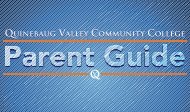QVCC Catalog 2016-2017
You also want an ePaper? Increase the reach of your titles
YUMPU automatically turns print PDFs into web optimized ePapers that Google loves.
Plagiarism is defined as the submission of work by a student<br />
for academic credit as one’s own work of authorship which<br />
contains work of another author without appropriate<br />
attribution.<br />
Cheating includes, but is not limited to: (i) use of any<br />
unauthorized assistance in taking quizzes, tests or<br />
examinations; (ii) use of sources beyond those authorized by<br />
the instructor in writing papers, preparing reports, solving<br />
problems or carrying out other assignments; (iii) the<br />
acquisition, without permission, of tests or other academic<br />
material belonging to a member of the University faculty or<br />
staff; and (iv) engaging in any other behavior specifically<br />
prohibited by a faculty member in the course syllabus.<br />
2. Acts of dishonesty, including but not limited to the<br />
following:<br />
A. Misuse of University or College documents, including,<br />
but not limited to forging, transferring, altering or<br />
otherwise misusing a student fee card, student payroll<br />
card, identification card or other College or University<br />
identification document, course registration document,<br />
schedule card, transcript, or any other institution-issued<br />
document or record.<br />
B. Knowingly furnishing false information to any CSCU<br />
Official, faculty member or office.<br />
3. Theft of property or services, or damage to, defacement or<br />
destruction of, or tampering with, real or personal property<br />
owned by the State of Connecticut, CSCU/BOR, the<br />
institution, or any member of the CSCU community.<br />
4. Actual or threatened physical assault or abuse, threatening<br />
behavior, intimidation, or coercion.<br />
5. Sexual misconduct may include engaging in one of more<br />
behaviors:<br />
A. Sexual harassment, which can include any unwelcome<br />
sexual advance or request for sexual favors, or any<br />
conduct of a sexual nature when submission to such<br />
conduct is made either explicitly or implicitly a term or<br />
condition of an individual’s education; submission to or<br />
rejection of such conduct by an individual is used as a<br />
basis for academic decisions affecting the individual; or<br />
such conduct has the purpose or effect of substantially<br />
interfering with an individual’s academic performance or<br />
creating an intimidating, hostile or offensive educational<br />
environment. Examples of conduct which may<br />
constitute sexual harassment include but are not limited<br />
to:<br />
<br />
<br />
<br />
<br />
<br />
sexual flirtation, touching, advances or propositions<br />
verbal abuse of a sexual nature<br />
pressure to engage in sexual activity<br />
graphic or suggestive comments about an<br />
individual’s dress or appearance<br />
use of sexually degrading words to describe an<br />
individual<br />
<br />
<br />
<br />
<br />
display of sexually suggestive objects, pictures or<br />
photographs<br />
sexual jokes<br />
stereotypic comments based upon gender<br />
threats, demands or suggestions that retention of<br />
one’s educational status is contingent upon<br />
toleration of or acquiescence in sexual advances.<br />
B. Sexual assault shall include but is not limited to a sexual<br />
act directed against another person when that person is<br />
not capable of giving consent, which shall mean the<br />
voluntary agreement by a person in the possession and<br />
exercise of sufficient mental capacity to make a<br />
deliberate choice to do something proposed by another.<br />
A person who initially consents to sexual activity shall be<br />
deemed not to have consented to any such activity<br />
which occurs after that consent is withdrawn. Consent<br />
cannot be assumed because there is no physical<br />
resistance or other negative response. A lack of consent<br />
may result from mental incapacity (e.g., ingestion of<br />
alcohol or drugs which significantly impair awareness or<br />
judgment) or physical incapacity (e.g., the person is<br />
unconscious or otherwise unable to communicate<br />
consent). Sexual assault is further defined in sections<br />
53a-70, 53a-70a, 53a-70b, 53a-71, 53a-72a, 53a-72b and<br />
53a-73a of the Connecticut General Statutes.<br />
C. Sexual exploitation occurs when a person takes nonconsensual<br />
or abusive sexual advantage of another for<br />
anyone’s advantage or benefit other than the person<br />
being exploited, and that behavior does not otherwise<br />
constitute one of the preceding sexual misconduct<br />
offenses. Examples of behavior that could rise to the level<br />
of sexual exploitation include:<br />
<br />
<br />
<br />
<br />
<br />
<br />
<br />
<br />
Prostituting another person;<br />
Non-consensual visual (e.g., video, photograph) or<br />
audio-recording of sexual activity;<br />
Non-consensual distribution of photos, other images,<br />
or information of an individual’s sexual activity,<br />
intimate body parts, or nakedness, with the intent to<br />
or having the effect of embarrassing an individual<br />
who is the subject of such images or information;<br />
Going beyond the bounds of consent (such as letting<br />
your friends hide in the closet to watch you having<br />
consensual sex);<br />
Engaging in non-consensual voyeurism;<br />
Knowingly transmitting an STI, such as HIV to<br />
another without disclosing your STI status;<br />
Exposing one’s genitals in non-consensual<br />
circumstances, or inducing another to expose his or<br />
her genitals; or<br />
Possessing, distributing, viewing or forcing others to<br />
view illegal pornography.



